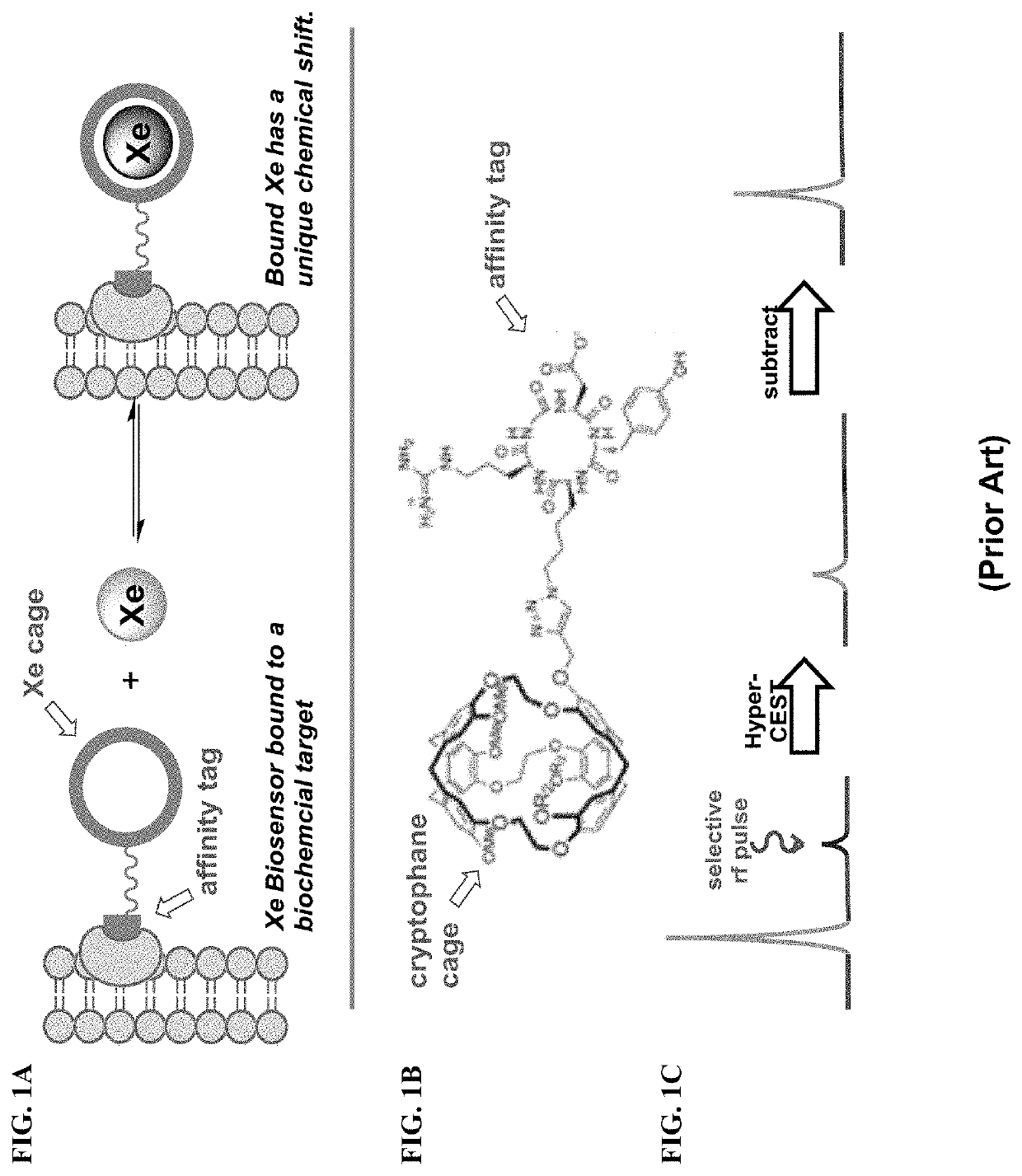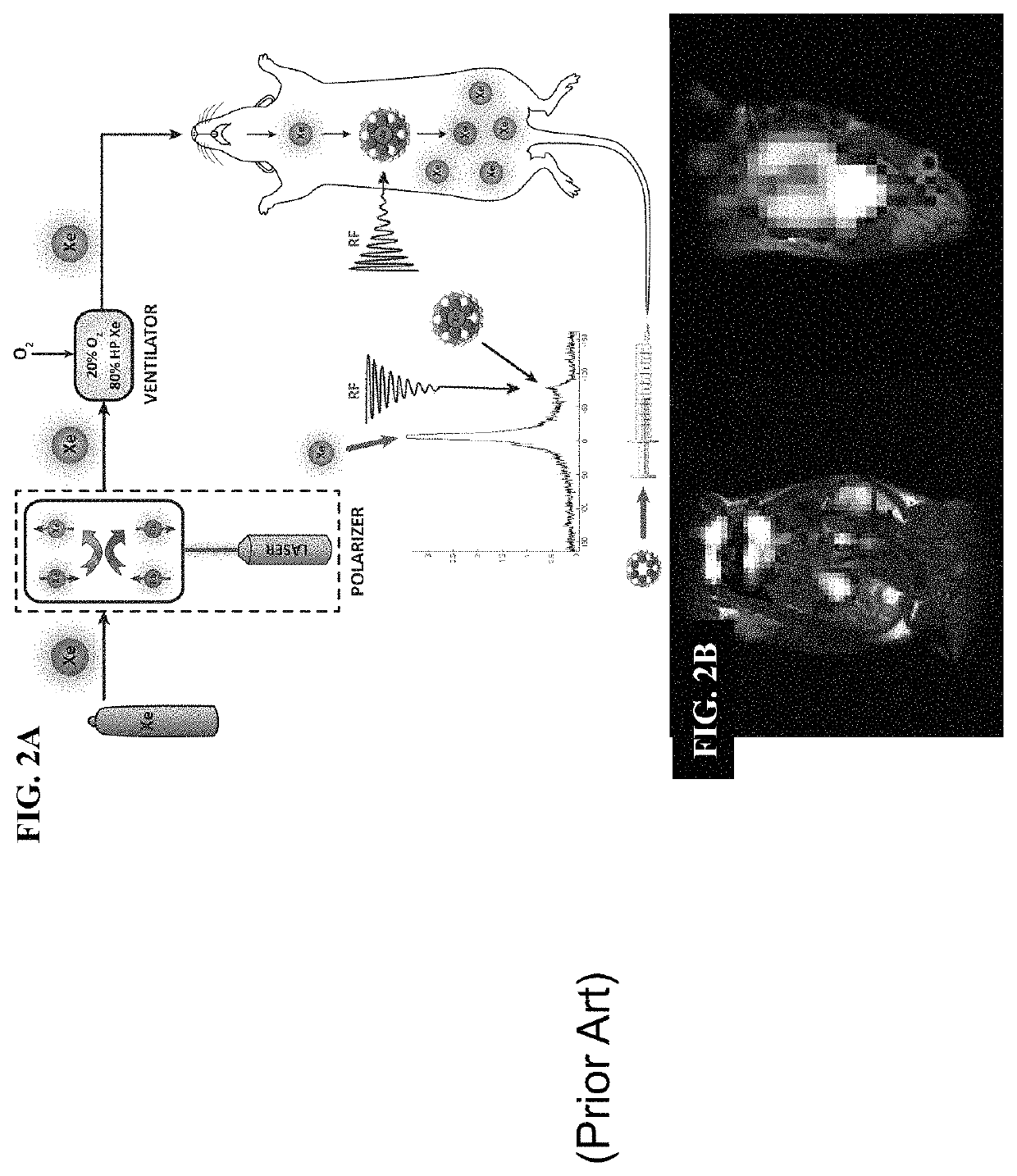Rotaxane-type probe for molecular imaging
a molecular imaging and rotaxane-type technology, applied in the direction of magnetic variable regulation, instruments, measurements using nmr, etc., can solve the problem that insufficient quantities of biosensors for in vivo imaging are simply not availabl
- Summary
- Abstract
- Description
- Claims
- Application Information
AI Technical Summary
Problems solved by technology
Method used
Image
Examples
example 1
[0036]In the following exemplary embodiments, we found: the rotaxane-type biosensor can be readily synthesized and conjugatable; and the molecule is MR detectable by displaying a HyperCEST effect. Towards the first aspect, we found that pillararenes were relatively easy to synthesize and CB and CD macrocycles are both commercially available. Each of the host macrocycle molecules listed in FIG. 4A (CB6, CB7, CB8, α, β and γ-CD) was threaded with five, eight and ten-carbon molecular axles / threads that each contained a pair of terminal ethylimidazolium groups, which served to enhance the water solubility of the greasy alkanes and enabled facile detection by mass spectrometry (FIG. 5A). Furthermore, similar moieties with attached affinity tags can be created following the same or similar rationales by one of ordinary skills in the art. For example and referring to FIG. 5B, azide-containing threads were conjugated to affinity tags via Hugsien cyclo-addition and synthesized for the presen...
example 2
[0045]To demonstrate and test the utility of this new class of xenon-binding agents for the synthesis of targeted biosensors, we synthesized a potential molecular probe using thioflavin T (ThT) as part of the affinity tag. ThT is a fluorescent dye that has an affinity for binding to the β-amyloid plaques that have been implicated with the onset and progression of neurodegenerative diseases such as Alzheimer's disease (AD).40 Using HP Xe biosensors such as this, the present invention provides clinical applications for studying the progression of AD and / or the efficacy of treatments for this and other diseases.
[0046]Referring now to FIG. 10A, the synthesis of this biosensor embodiment involves a simple acylation, followed by the formation of the pseudo-rotaxane. Both steps are nearly quantitative. As before, formation of the 1:1 complex was confirmed by 1H NMR studies, and the association constant for the pseudo-rotaxane was determined to be 2.0×104 M−1. The reactions are simple and h...
example 3
[0049]In order to synthesize a more stable HP-Xe probe, rotaxanes are developed to contain large end groups on the alkyl chains that will prevent the dissociation of the macrocyclic hosts and their linear guests. Two strategies for synthesizing this kind of compound (FIG. 11) are employed.
[0050]We have found that the simple SN2 displacement of alkyl bromides by imidazole nucleophiles in refluxing toluene is a reliable method for constructing the alkyl chains that form the threads / axles of rotaxane complexes. Consequently, a rotaxane was designed to contain anthracene stoppers / end groups that would prevent de-threading and imidazoles that would allow for facile construction of the thread. Klotz, E. J. F., et al., J. Am. Chem. Soc. 2006, 128 (48), 15374-15375. When the reaction shown in FIG. 11A was performed, the formation of complex 7 was observed as a precipitate, and its structure was confirmed by 1H NMR—supramolecular structure 7 appeared to be remarkably stable. Despite the pote...
PUM
| Property | Measurement | Unit |
|---|---|---|
| affinity | aaaaa | aaaaa |
| time | aaaaa | aaaaa |
| water-soluble | aaaaa | aaaaa |
Abstract
Description
Claims
Application Information
 Login to view more
Login to view more - R&D Engineer
- R&D Manager
- IP Professional
- Industry Leading Data Capabilities
- Powerful AI technology
- Patent DNA Extraction
Browse by: Latest US Patents, China's latest patents, Technical Efficacy Thesaurus, Application Domain, Technology Topic.
© 2024 PatSnap. All rights reserved.Legal|Privacy policy|Modern Slavery Act Transparency Statement|Sitemap



